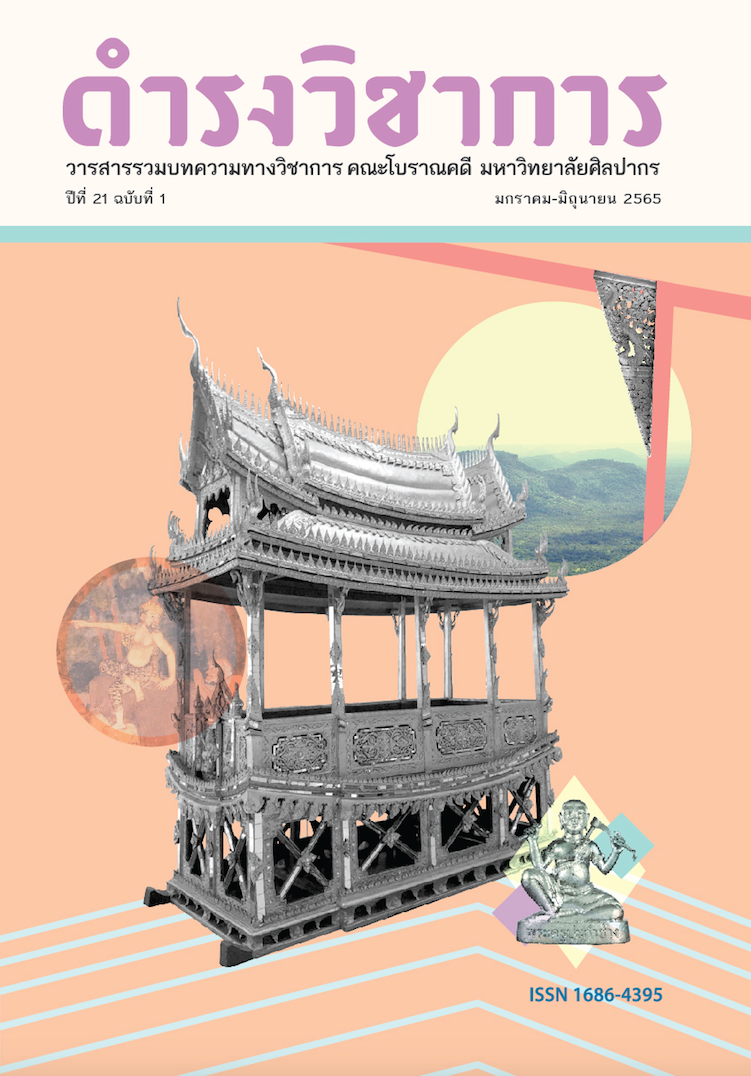Rishis in Rammakian by King Rama I
Keywords:
Rishis, Rammakian, King Rama IAbstract
This article aimed to study the dominant characteristics, roles and some observation of the character creation of Rishis in the drama Rammakian by King Rama I. The results found that the dominant characteristics of Rishis are divided into 5 characteristics: (1) benevolent, (2) having profound knowledge of sciences and arts, (3) having power, (4) having intuition, and (5) having perseverance in religious routine. Rishis in the story have 7 roles: (1) protector, (2) consultant, (3) communicating with gods, (4) mediator, (5)creators of various stories, (6) producers of Rasa in literature, and (7) teaching new ideas. There are four interesting aspects to Rishis character creation: (1) Rishis are a senior person like an honorable relative, (2) Indian seers were adapted into Thai own Rishis (3) The Rishi in literature is related to the Rishi in urban legends (4) Rishis who were related to Rāvaṇa were gullible. This study contributes to the understanding of the genius of the Thai poets who created the dominant characteristics and roles of the Rishis in the drama Rammakian of King Rama I.
References
ภาษาไทย
กุสุมา รักษมณี และคณะ, 2550. ศักดิ์ศรีและความอับอายในวรรณกรรมไทย. กรุงเทพฯ: แม่คำผาง.
กรมศิลปากร, 2558. บทความเรื่องรามเกียรติ์. กรุงเทพฯ: สำนักวรรณกรรมและประวัติศาสตร์ กรมศิลปากร.
กรมศิลปากร, 2540. บทละครเรื่องรามเกียรติ์ พระราชนิพนธ์ในรัชกาลที่ 1 เล่ม 1. กรุงเทพฯ: กอง
วรรณกรรมและประวัติศาสตร์ กรมศิลปากร.
, 2540. บทละครเรื่องรามเกียรติ์ พระราชนิพนธ์ในรัชกาลที่ 1 เล่ม 2. กรุงเทพฯ: กอง
วรรณกรรมและประวัติศาสตร์ กรมศิลปากร.
, 2540. บทละครเรื่องรามเกียรติ์ พระราชนิพนธ์ในรัชกาลที่ 1 เล่ม 3. กรุงเทพฯ: กอง
วรรณกรรมและประวัติศาสตร์ กรมศิลปากร.
, 2540. บทละครเรื่องรามเกียรติ์ พระราชนิพนธ์ในรัชกาลที่ 1 เล่ม 4. กรุงเทพฯ: กอง
วรรณกรรมและประวัติศาสตร์ กรมศิลปากร.
ชลดา เรืองรักษ์ลิขิต, 2559. “แก่นเรื่องและบทบาทของแก่นเรื่องในบทละครเรื่องรามเกียรติ์ พระราชนิพนธ์
ของพระบาทสมเด็จพระพุทธยอดฟ้าจุฬาโลกมหาราช.” วารสารมนุษยศาสตร์และสังคมศาสตร์
มหาวิทยาลัยราชภัฏสุราษฏร์ธานี 8 (3) : 1-29.
นาคะประทีป, 2547. สมญาภิธานรามเกียรติ์. กรุงเทพฯ: เคล็ดไทย.
มงกุฎเกล้าเจ้าอยู่หัว,พระบาทสมเด็จพระ. 2547. เทพเจ้าและสิ่งน่ารู้พระราชนิพนธ์ ร.6. กรุงเทพฯ:
ศรีปัญญา.
ราชบัณฑิตยสถาน, 2546. พจนานุกรมฉบับราชบัณฑิตยสถาน พ.ศ. 2542. กรุงเทพฯ: นานมีบุ๊คส์
พับลิเคชั่นส์.
รื่นฤทัย สัจจพันธุ์, 2554. นามานุกรมรามเกียรติ์ ฉบับปรับปรุงใหม่. กรุงเทพฯ: สถาพรบุ๊คส์.
, 2544.วรรณคดีศึกษา. กรุงเทพฯ: ธารปัญญา.
วรรณวรางค์ พัฒนกำจร, 2532. “ฤษีอคัสตยะในวรรณคดีสันสกฤต.” วิทยานิพนธ์อักษรศาสตรมหาบัณฑิต
บัณฑิต ภาควิชาภาษาตะวันออก บัณฑิตวิทยาลัย จุฬาลงกรณ์มหาวิทยาลัย.
ศักดิ์ศรี แย้มนัดดา, 2522. “ฤษี.” เมืองโบราณ 5 (5): 71-79.
ศรีสุรางค์ พูลทรัพย์, 2545. “ฤษีในวรรณคดีและคติความเชื่อของอินเดีย.” วารสารราชบัณฑิตยสถาน
(3) : 878-882.
สุรพงษ์ โสธนะเสถียร, 2526. “รามเกียรติ์: การเปลความหมายทางการเมือง.” วิทยานิพนธ์รัฐศาสตร์ดุษฏี
บัณฑิต ภาควิชาการปกครอง บัณฑิตวิทยาลัย จุฬาลงกรณ์มหาวิทยาลัย.
สุรพล ดำริห์กุล, 2557. “โบราณสถานสันกู่ ดอยปุย: พื้นที่ศักดิ์สิทธิ์ของพระฤาษีวาสุเทพ?,”
วารสารวิจิตรศิลป์ 5 (1): 1-20.
ภาษาอังกฤษ
Monier-Williams, Monier, Sir. 1899. A Sanskrit English Dictionary. London: Oxford the
Clarendon Press.
Sundaram, P.S. trans. 2002. The Kamba Rāmāyaṇa. New Delhi: Penquin Books India.
Downloads
Published
Issue
Section
License
Copyright (c) 2022 Damrong Journal of The Faculty of Archaeology Silpakorn University

This work is licensed under a Creative Commons Attribution-NonCommercial-NoDerivatives 4.0 International License.
บทความนี้เป็นผลงานของข้าพเจ้าแต่เพียงผู้เดียว และ/หรือเป็นผลงานของข้าพเจ้าและผู้ร่วมงาน ตามชื่อที่ระบุในบทความจริง และเป็นผลงานที่มิได้ถูกนำเสนอหรือตีพิมพ์ที่ใดมาก่อน





